Tibetan yoga gTum-mo: physics, physiology and know-how of cold-resistance
Published in the book "Proceedings of the Sixth International interscience scientific and practical conference VAJRAYANA BUDDHISM IN RUSSIA: TOPICAL ISSUES OF HISTORY AND SOCIOCULTURAL ANALYTICS which took place on October 19-22, 2018 in St. Petersburg"
Minvaleyev R.S., Timofeyev I.V., Ivanov A.I., Levitov A°
St.Petersburg State University (Russia)
°Eastern Virginia Medical School (USA)
Tibetan yoga gTum-mo: physics, physiology and know-how of cold-resistance
According to Tibetan Buddhism traditions, cold resistance enhancement when practicing gTum-mo is introduced in two basic respects: as a side effect of tantric practices and as a criterion of successful implementation. We have considered the Tibetan yoga gTum-mo in terms of natural Sciences (physics and physiology) and reconstructed the practice of gTum-mo as the technology for quickly enhance the cold resistance without stress response. We excluded all religious insinuations as unnecessary to achieve of cold resistance.
Кеу words: yoga, gTum-mo, physiology, physics, cold resistance.
On the one hand, Tibetan yoga gTum-mo, a basic practice of six yogas of Naropa, refers to one of the most closed psychotechnics of Tibetan Buddhism, on the other hand, it is a sort of a ’business card’ of Tibetan Tantrism. The ability of gTum-mo adepts to resist cold for a long time without any signs of cold stress has always drawn attention of onlookers [David-Néel,1929; Eliade, 1958]. NK Rerikh’s famous painting On the heights where a naked yogi in the lotus position against snow-capped mountain peaks is depicted might have been painted from life.
According to Tibetan Buddhism traditions, cold resistance enhancement when practicing tummo is introduced in two basic respects - as a side effect of tantric practices and as a criterion of successful implementation [Thubten Yeshe, 1998; Mouzroukov, 2013].
From the point of view of natural science, out of the all the six yogas of Naropa it is precisely yoga gTum-mo that can be considered a verifiable phenomenon, as heat development mechanisms of an endothermic organism do not involve any metaphysical concepts which permeate other phenomena of Tibetan Buddhism. For instance, in one of the six yogas of Naropa [Readings on The Six Yogas of Naropa, 1997] we come across the teaching of Je Tsongkhapa, a great reformer of Tibetan Buddhism, the founder of the Gelug school, second Buddha, etc., about the transference of consciousness (in Tibetan ‘phowa’) to an ’abscessless’ dead body followed by its reanimation. Moreover, there is a description of a detailed preliminary testing on ’reanimation’ of a cow’s or other cattle’s cadaver [Readings on The Six Yogas of Naropa, 1997]. Religious teachings of the kind have no subject matter within the natural-science paradigm and deserve ethnographic interest at best [Wylie, 1964]. By contrast, successful implementation of gTum-mo yoga is verified by quite doable physical cold resistance testing [David-Néel, 1929], which are performable in autoexperiments [Minvaleev, 2014], and objectively explorable. Otherwise stated, the object of the given work was to find the real component of gTum-mo practice, which can and should be distinguished within the natural-science paradigm separating it from the irrelevant religious-ritualistic component.
Thus, it raises the first question about the cold resistance enhancing mechanisms of the kind, which has inspired a number of scientists to research Tibetan monks practicing gTum-mo in their domicile.
Objective research
In 1981, by invitation of the Dalai-Lama associated professor Herbert Benson and a group of his colleagues arrived in Dharamsala (Northern India) where he was provided with an opportunity to study three Buddhist monks in situ [Benson, 1982]. The experiments were carried out in February, 1981 in conditions quite severe for that time but judging by the published results the monks refused to be subjected to actual cold tests. Namely, throughout all the experiments the temperature of the room for testing did not go below the standard comfortable range (from 16 to 20 ⁰С), which results from all the three temperature diagrams available in the work (the most illustrative is Fig. 1).
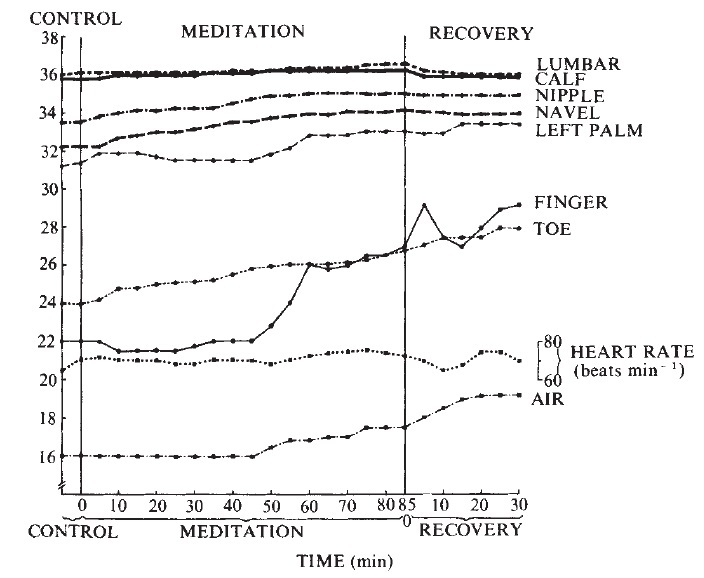
Fig. 1. Skin and air temperature and heart rate changes before, during and after the practice of g Tum-mo meditation in subject J. T. [Benson, 1982, 235]
The conclusions only report that ’these subjects exhibited the capacity to increase the temperature of their fingers and toes by as much as 8,30С’. As the found result quite fit into the concept of H.Benson himself about ’Relaxation Response’, which he describes as ’a physiological condition contrary to stress’ [Benson, 1975], the authors of the article apparently had no claims against the monks. Supposedly, the American scientists had not insisted and the monks had decided that it ought to have been so.
In fact, piecewise linear graphic interpretation of temperature leads on the fingers and toes of the monks under examination (who, according to their own stories, had spent more than 6 years studying gTum-mo practice) suggests that H.Benson and his colleagues documented the well-known peripheral reheating results of the subjects after they return to a warm room from the cold (see Fig. 2).
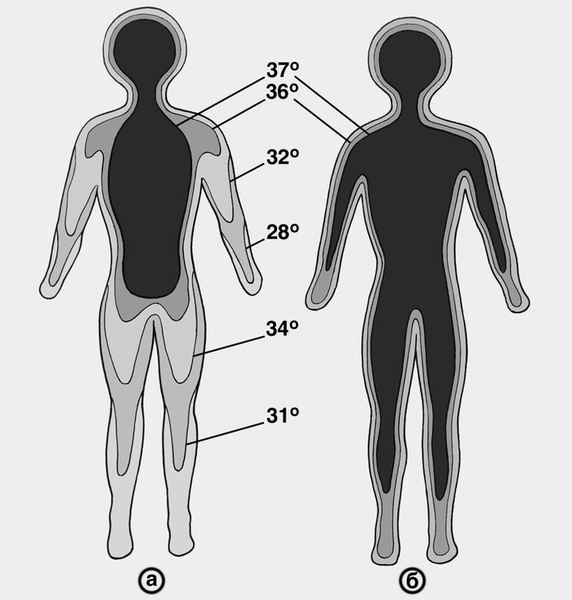
Fig.2. Isothermal lines of a naked person in response to the cold (a) and heat (b) [Herman, 2007]
Otherwise stated, in this research the issue of objective examination of the actual cold resistance was never raised. The arisen discussion published in July, 1982 in the same Nature [Pasachoff, Strassburg, Benson, 1982, 402] left a number of questions unanswered, and in 2001 H.Benson managed to get financed by the Guinness Family Fund in the amount of $1,250,000 to research the uncanny abilities of Tibetan monks to reheat in the cold without fire or clothes. The funding gave an opportunity to deliver three monks capable of gTum-mo to the Guinness estate in Normandy to study their cold resistance abilities directly. It happened in July, 2001. Upon arrival it turned out that the ’gTum-mo masters’ could not demonstrate their wonderful abilities at once and they demanded at least ’100 days to reach their full meditative capacity’. All this time they were staying at the Guinness estate with H.Benson’s team, until one of the monks got an eye infection and withdrew from the experiment. At last, in November, 2001 the scientists carried out the necessary testing of cold resistance (Fig. 3). This photo document and a brief article in the newspaper of Harvard University [Cromie, 2002] inform us that ’the team obtained valuable data’. However, as Benson personally admits, ’the room was not cold enough to do the tests properly’. In short, in twenty years the scientist repeated the same approach as in the Himalayas studies in 1981.
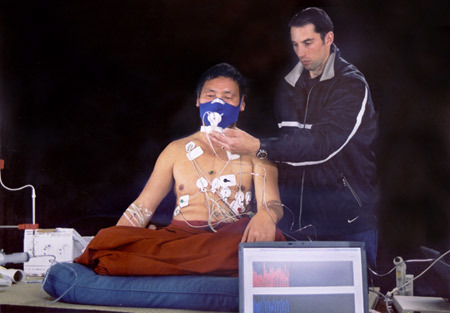
Fig. 3. A Buddhist monk has his vital signs measured as he prepares to enter an advanced state of meditation in Normandy, France. During meditation, the monk’s body produces enough heat to dry cold, wet sheets put over his shoulders in a frigid room.
Photo courtesy of Herbert Benson
What happened further? A quotation from the newspaper of Harvard University: ’His team will try again this coming winter with six monks. They will start practice in late summer and should be ready during the coldest part of winter’. That is the end of the available information about 20 years long research of gTum-mo practice by professor Benson’s.
The second published research was carried out by Maria Kozhevnikova and her colleagues in a remote cloister in Amdo district of Tibetan Plateau. However, by the description of the conditions of the experiment M. Kozhevnikova and her colleagues were never admitted into the room where it was carried out, by which the published results of a single body temperature rise up to 38⁰С were largely depreciated [Kozhevnikov, 2013].
Cold resistance as is
The first question which was never answered by Benson or Kozhevnikova is quite obvious: where is it, the renowned cold resistance of Tibetan monks? And if such monks do exist, how do their cold resistance abilities exceed those of a Caucasian who does not practice Buddhist meditation?
It is common knowledge that maximum permissible cold resistance was studied in 1942–1943 by SS-doctors under Sigmund Rascher’s supervision in Dachau concentration camp. In particular, an important for the Nazis subject of research was cold resistance of people of different nationalities [Burton, 1955]. As far as it can be understood from the available data of the research condemned alongside other SS crimes at Nuremberg trials, the highest level of cold resistance was demonstrated by Slavic captives in particular. That might be one of the reasons why maximum permissible cold resistance experiments (already not criminal) were resumed in the USSR. Unfortunately, most of those works are still classified, but even a fleeting look at some of them makes you forget about the wonders of Tibetan respahs.
In 1978, a Soviet popular science journal (Himia and Zhizn’) published the article Hunger against Cold by PhD in Medicine Alexey Yuryevich Katkov, whose author, one of the pioneers of the physiological approach to yoga studies, provided a summary report on various cold resistance phenomena including gTum-mo practice [Katkov, 1978, 56]. Later, A.Ju. Katkov carried out experiments of those phenomena on volunteers and himself, which made the feats of Tibetan yogi and all kinds of cold resistance wonders from Guinness World Records pale in comparison.
Shortly before his tragic death on Elbrus, working for the military forces and the space programme of the USSR, A.Ju. Katkov performed astonishing experiments involving volunteers at Institute of Medical and Biological Problems (Moscow). Those amazing people - guinea pigs, as they called themselves, but, in fact, superheroes of the Soviet era, ready to undergo testing - could endure not only maximum permissible but over-extreme conditions in the climatic altitude chamber. Many participants of those tests are still alive and well. One of them is Boris Korshunov (b. 1935), famous among mountaineers as a legendary person of the Soviet alpine climbing. Let’s grant him permission to speak: ’There was a lot of research in bringing reserves of a human body to light. I’ll tell you about one of the experiments carried out in 1977 or 1978, I don’t remember exactly. I was one of the team of six testees… The task was to check the human organism for survival at extremely low temperatures and high altitude. For an hour, we were placed naked into the altitude chamber (altitude - 7,500m) at the temperature – 60оС… A warmly clad female doctor was with us, capturing the data. Naked, we were sitting in airplane armchairs and at –60оС all the hairs on our bodies, whichever the length, were standing on end, it was clear that in those conditions an intermediate layer of a higher temperature was being formed at the surface of the body. Then doctor who was observing us suggested switching on the altitude chamber ventilator two meters in diameter every ten minutes to blow off this intermediate layer. I should say, we had a very tough time at –60оС and the vent on for an hour...’
This interview appeared on one of the sites devoted to history of Russian alpine climbing [Laletina, 2006]. We copied it almost to the dot as only the military forces benefited from all the numerical results of those unique experiments and they will hardly be open to the public any time soon. Nevertheless, below we adduced our approximate thermophysical estimations due to the mentioned criteria of those experiments.
How do we cool off?
It is evident that all the bodies (living or nonliving, having achieved the tantric realization or just exposed to the cold) follow laws of thermal physics, and as far as living bodies are concerned, the renowned laws of thermotaxic physiology come in. Heat loss of a naked body at relative rest comes down to thermal conductivity (convection), evaporation via perspiration and thermal emission. Perspiration stops in freezing temperatures, in this case heat loss amounts to heat emission off the surface of the body through convection adding heat shedding. To sum up, the organism cools off while heating the air due to the difference of the temperatures between the air and the body as well as radiating heat in the infrared band. The formulae for quantitative estimation of the aforementioned processes are well-known [Burton, 1955, Herman, 2007].
Meaning, heat losses at the expense of conduction are described in Newton’s cooling law (1) – cooling rate of a body is directly proportional to the surface area of the body and the difference between the temperatures of the body surface and the environment:
H = C·S (T – Tв), (1)
where H – rate of heat loss in kcal/h,
T – temperature of the body (37оС or 273 + 37 = 310 K – degrees Kelvin),
Tв – temperatures of the environment (273 – 60 = 213 K),
S – surface area of the body (for an average adult it is considered to be 1,8 sq.m),
C – surface heat exchange coefficient (for the human body it is approximately 4 W/sq.m·K). Convection heat transfer under such conditions comprises about 700 W, or 600 kcal/h.
Radiation heat losses are calculated by Stefan-Boltzmann’s law (2):
Р = σ·ε·S·(Тs4 – Тa4), (2)
where Р – heat energy lost by a person via radiation due to the interaction with the environment,
Тs – average skin temperature acquired at the lower tolerance threshold at 20оС,
σ – Stefan-Boltzmann’s constant equal to 5,7·10-8 W/sq.m·K 4,
ε – adjustment coefficient for a white person’s skin equal to 0,55. In this case the heat loss of a naked person via radiation at –60оС for an hour amounts to 300 W, or 250 kcal/h.
In total, the resulting heat losses of a naked person under the given conditions comprise approximately 1,000 W, or 860 kcal/h.
Inspiratory air heat losses are also mentioned in most physiology textbooks in this section. However, the accurate calculation of the required amount of heat shows remarkablу infinitesimals. Thus, warming of 0.5l of air (average inspiratory volume) from –60оС to +35оС requires only 0.015 kcal. A person inhales about 500l an hour expending 15kcal – 1.5% of the resulting heat losses of 860 kcal/h. The reason is extremely little air thermal capacity: only 0.241 kcal/kg∙K.
How do we warm up?
The calculated heat losses must be compensated by heat production, otherwise our protagonists would not have survived. It is a conventional belief that all the cells of the organism produce heat, as oxidation processes are in progress. It is also assumed that to support constant temperature additional heat is produced:
1) by skeletal muscle contractions not only voluntary but also involuntary, i.e. cold shivering; contractile thermogenesis releases 800 W;
2) due to up-regulation of internal heat release unrelated to muscle contractions; non-contractile thermogenesis releases about 400 W.
In this case the total of contractile and non-contractile thermogenesis amounts to 1200 W (about 1000 kcal/h) [Fanger, 1970], which does not surpass considerably the heat losses of the organism at the temperature –60оС within an hour.
In other words, by approximation calculation everything coincides right down to the assumptions made. It turns out that Tibetan monks demonstrate no wonders and a cold friendly person without any years long Buddhist meditation can survive this deadly - at first sight - cold.
Why the shell cannot heat the core
In 1850 professor of Berlin University Rudolf Clausius states one of the fundamental laws of nature: ’Heat cannot transit by its own volition from a colder body to a warmer one ’ [Clausius, 1850]. This postulate, famous as the second law of thermodynamics in the initial definition by Clausius, is ignored in most works on thermoregulation of a warm-blooded organism. The matter is that elevated temperature of warm-blooded animals is constant only in the ’core’ of the organism. That’s exactly why such animals are more accurately called homoiothermal – with the permanent temperature. And this core is surrounded by a shell of peripheral tissues whose temperature is lower and in a greater degree depends on the environment, i.e. becomes cold in freezing temperatures as with cold-blooded (poikilothermal - with changeable temperature) animals. In Fig. 2 there are isotherms which show the ratio of a homoiothermal body core with weighted average temperature 37оС and its poikilothermal shell whose temperature varies depending on ambient temperature.
It is easily seen that under the conditions of cold almost all skeletal muscles are in the area of lowered temperature. Thus, according to the second law of thermodynamics, heat transfer can only be directed from the core of the body outwards, to the muscles and then from the muscles further to the next ’fridge’, i.e. into the outside environment. Therefore, whatever the quantity of the produced by muscles heat, they can heat inner organs only if heat-insulating external layer is available. It can be fur, wool or warm clothing made of the aforementioned wool or fur, which create a layer of air around the body and return the heat to the organism. For a naked person, all the heat produced by skeletal muscles will be used for heating the environment, but not the ’core’ of the body.
In summary, contractile thermogenesis in muscles can be of any use only if heat insulation is available.
Homoiothermia is not only warm-bloodedness
An interesting fact is that for the first time the heat-producing ability of isolated muscles was noted in the tailor’s muscle of a frog (frog sartorius) – a typical cold-blooded animal, and up to the present day the quantitative ratios for heat-production components are known only for the muscles of amphibians. Even though it is unclear how applicable they are to warm-blooded animals, most works in physiology of thermoregulation imply universalism of these ratios. Accordingly, after in 1949 English physiologist Archibald Vivien Hill (the Nobel prizeman in 1922 for ’advances in the production of heat in muscles) found out that heat production of a single contraction of a toad’s muscle is 3 mcal/g [Hill, 1949], this exact figure was named in scientific literature as the energy constant of a single muscle contraction typical for all the other animals including the human being [Bendall, 1969].
But the muscle ability of amphibians to diffuse energy in the form of heat does not make them warm-blooded animals. Most flies can also generate heat by contracting their flight muscles. For instance, in spring a bumblebee sets out first to collect nectar, as the fluff on its body helps it keep the heat produced by the flight muscles. As for the vanessa butterfly, even in cool weather at 10оС by fluttering its wings it manages to warm itself up to 35оС within minutes, and during the flight its temperature reaches 37оС, as with warm-blooded species. But insects are incapable of thermal stability, which is called homoiothermia.
The main point of homoiothermia is not in the fact that muscles of warm-blooded animals produce more heat than frog’s muscles, it is all about а fundamentally different pattern of reaction for the temperature of the environment. When the environment temperature drops, the metabolism of cold-blooded animals decreases up to complete anabiosis. The reaction of warm-blooded animals and human beings is absolutely different: with the ambient temperature rising, the metabolism must decrease, and with falling ambient temperature - vice versa, it increases to produce more heat. It depends only on the source of this additional heat, which most works on physiology traditionally associate with musclar thermogenesis, both contractile and non-contractile [Ivanov, 1980].
As noted above, it contradicts the second law of thermodynamics in the original form by R.Clausius. Muscular and connective tissue membranes are essentially unable to heat the core and perform as thermal insulators at best. Vasomotor reactions of cold adaptation are provided for this purpose, they ensure that peripheral blood supply reduces dramatically which indeed decreases heat loss. However, only skin and muscle coat is clearly a bad heat insulator for a naked man in the cold with piercing wind. For this very reason, famous Canadian researchers of cold resistance Alan Burton and Otto Edholm, the authors of the classical work Man in a cold environment, call the environment temperature of +2оС absolutely deadly for a naked person [Burton, 1955].
If the source for heating the ’core’ of a human body, it must be deep inside the body. Liver, intestine and brown fat are often mentioned as potential organs of inner heat production. However, rough calculations prove that they are not enough to compensate for the heat losses of a naked person in the piercing cold.
So little brown fat
A lot of reports about extremely high thermoregulatory activity of brown adipose tissue have arisen in the last 50 years. It is clusters of brown fat cells scattered all around the organism. Noticeable amounts can be traced only in mammals and, in contrast with the common white fat which oxidizes in the liver, brown fat oxidizes its components (fatty acids and glycerol) within its own cell, whereby most part of the oxidation energy becomes heat. It is of brown colour due to abundance of mitochondria, where intensive lipid oxidation takes place. It is brown fat that enables animals to swim in cold seas and survive during winter slumber. Besides, large accumulation of brown fat prevents mammal youngsters from supercooling due to rapid temperature change at birth. The same mechanism of non-contractile thermogenesis in brown adipose tissue is found with human new-born babies. Unfortunately, relative mass ratio of brown fat in an adult’s body hardly amounts to 1% of body weight [Cypess, 2009], and the accurate calculation of the greatest possible contribution of brown fat into heat production proves that its heat diffusion can raise the body temperature by hardly 0,05оС (by condition of maximum permissible cell internal temperature of 42оС). It is evident that brown fat cannot be viewed as an efficient heat source for protecting a human being from cold [Ivanov, 2007, 68].
To give a complete picture let us consider the liver which is also viewed as a significant contributor into heat production. However, its relative mass ratio is not significantly larger than the amount of brown fat in a human organism: the average liver weight of 1,5 kg barely equals to 2% of an average person’s weight of 70 kg. Even though the temperature in the liver is two or three degrees more, its heat production potential needed for heating the ’core’ of the body does not go far beyond this. The temperature difference inside and outside the liver is too little, and the volumetric blood velocity through the liver is too little as well. The same can be said about the heat production in the intestine. Rough calculations prove that only abdomen heat production is clearly not enough to support homoiothermia, especially at −60оС.
Thermogenesis in lungs?
In 1960 he publishing house of Academy of Sciences of the USSR issued a monograph by Soviet biophysicist of Austrian descent, senior associate of Biophysics Institute of ASUSSR, K.S. Trincher with at first sight quite an intricate title Heatproducing function and reactional alcalinity of lung tissue [Trincher, 1960]. The author’s doubts upon naming the book so vaguely were not unfounded. The role of the airways and lungs in cooling the over-heated with its own heat homoiothermic organism is renowned. For instance: in the heat a dog breathes frequently with its tongue stuck out which prevents the fur-covered animal deprived of perspiratory glands from overheating. But the participation of the lungs in the production of heat - a phenomenon discovered, in fact, by K.S.Trincher, – is still a well-grounded but not conclusively proved hypothesis.
Researching what became of the fats inside the organisms of warm-blooded animals, K.S.Trincher turned his attention to a well-known fact: when blood goes through the lungs, i.e. in the pulmonary circuit, it is stripped of the fats. This discovery was made by French physiologists H. Roger и L.Binet almost a century ago. Since then, vast experimental material has been accumulated and it has been specified what kind of fats, fatty acids and fat-like substances oxidize in the lungs.
In his last works written already in his native language, German, being professor of Vienna University, he called this phenomenon with a direct word ‘Fettverbrennung’ (in German: ‘fat burning’) [Trincher, 1991, 25]. Indeed, it is the lungs through which all the circulating blood passes within a short time that are the best candidate for the role of a heater which sustains the thermal homeostasis. In the heat the lungs will allow the blood to cool and in the cold, on the contrary, heat it. A significant advantage of the lungs as the main heat producing organ is that in the alveole there is no physical or chemical prohibition on the exceedence of the maximum permissible temperature of intracellular oxidation (not more than 42оС - temperature of protein folding), first of all, due to efficient heat transfer via the pulmonary circuit. By the way, the phenomenon of ’walking on fire’ is explained the same way: undisturbed circulation in the foot transfers the heat of the coals without allowing any thermal injuries.
The heated in the lungs blood like a warmed-up liquid transfer medium is delivered to the ’core’ of the body for its immediate heating, preventing the premature cooling of the extremities of a warm-blooded animal. This is the way hemodynamic thermal regulation of a warm-blooded animal is implemented. In addition, the power capacity of thermogenesis in the lungs should be much higher than the one of contractile and non-contractile thermogenesis.
What about gTum-mo?
Now we can get back to the mysterious practice of Tibetan yogi. This very non-respiratory lung function allows us to breathe in frosty weather, as freezing air heats along with blood due to intrapulmonary lipid oxidation which produces heat, carbon dioxide and water which is let out in the cold in the form of familiar clouds of ’vapour’.
However, the most significant of K.S. Trincher’s scientific result does not involve the theoretically and experimentally proven fact of nonenzymatic lipid oxidation in the lungs, but the discovery of the conditions causing this process. Having found out rise in temperature in the lungs of the experimental animals alongside acute blood loss, K.S. Trincher ennumerates and finds experimental support of the other conditions triggering intrapulmonary thermogenesis (Fig. 4).
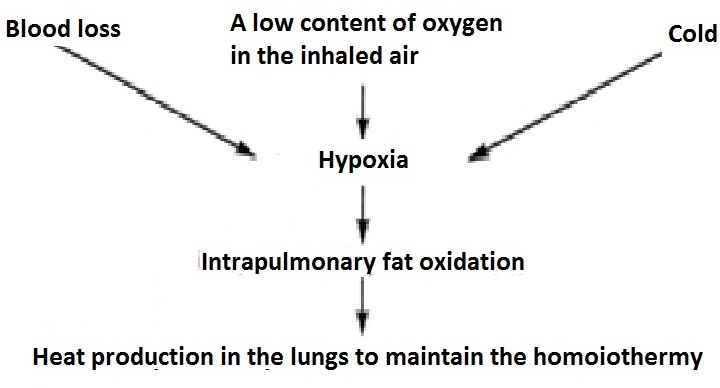
Fig. 4. Conditions triggering intrapulmonary thermogenesis [Trincher, 1991, 25]
The major purpose of science is to discover this kind of mechanisms. Phenomena which are in no way connected with each other turn out to have a linking pattern unknown before. In this case, it can be described in one word - hypoxemia, reduction of oxygen supply in blood. It triggers thermogenesis in the lungs not only in the cold, when the hypoxemic signal results from a peripheral vascular spasm, but also during physical activity when the muscles which actively consume oxygen from the blood, rapidly cause the same hypoxemic signal triggering the process of heat production in the lungs. That is why having warmed up to the point of sweat we take off the clothes in the cold so that it was more convenient to chop wood. Just in case, we will repeat it one more time: muscular (contractile) thermogenesis, which was considered responsible for the increased production of heat during intensive exercising, sends off all the produced heat to warm up the cold air around the body but not to the inner ’core’ of the body. As for the thermogenesis caused by functional hypoxia, it heats us under any conditions - both in the cold and, all the more so, in the heat.
Reconstruction
Our own research has enabled us to reconstruct the technology of tummo and to carry out experiments of the method un different conditions (air cooling, waterfalls, still cold water) [Minvaleev, 2014].
That was the exact approach that in his days enabled famous researcher of yoga practices Mircea Eliade to unite different ways of initiation of ’inner fat’ (shamanic fat, Vedic Tapas, Kundalini yoga and Tibetan gTum-mo) in a logical evolution of successive adoption: ’…gTum-mo is a yoga-tantric exercise well-known in the ascetic tradition of India. We have already mentioned the burning fever arising with the Kundalini awakening. The texts say that psychological heat appears by means of breath holding and transformation of sexual energy…’ [Eliade, 1958, 331]. it is worth pointing out that this conclusion of Mircea Eliade was not only based on comparative analogies but also on his own experience of mastering a number of yoga practices, including pranayamas, in ashrams of Rishikesh, Northern India.
The same conclusion was drawn by G.N.Mouzroukov who published detailed instructions in gTum-mo practice after studying in one of Tibetan monasteries in Amdo district of Tibet [Mouzroukov, 2013]. In our opinion, it was Mouzroukov’s own experience that gave grounds for labeling the practice of Kundalini awakening as ’predecessor of gTum-mo’, which enabled us as well to use the famous yoga technologies to reconstruct tummo techniques outside of tantric religious concepts.
Hypoxic stimulus of intrapulmonary thermogenesis according to [Trincher, 1960; Trincher, 1991] turned out to be quite an adequate explanation of the heating (tapas) effect of breath holding (pranayama) and propulsive movement of the anterior abdominal wall (Agnisara/ Nauli), which are also found among the exercises during the practice of gTum-mo [David-Néel, 1929].
In the practice of so-called Kundalini awakening (Fig. 5) the successive triple Bandha (Mula - Uddiyana - Jalandhara) was used in various variants. Sometimes all Bandhas were performed together, sometimes each Bandha was practiced separately in combination with asanas and/or pranayama (Maha Bandha, Bhujangasana, Mahamudra, Mahavedtha). All these techniques were presented in detail in the corresponding literature [The Yoga Upanishads, 1938], using it we restored them relying on the published methodology by Gleb Mouzroukov [Mouzroukov, 2013], a number of published texts on tummo practice [Teaching of Tibetan yoga, 1963; Thubten Yeshe, 1998].
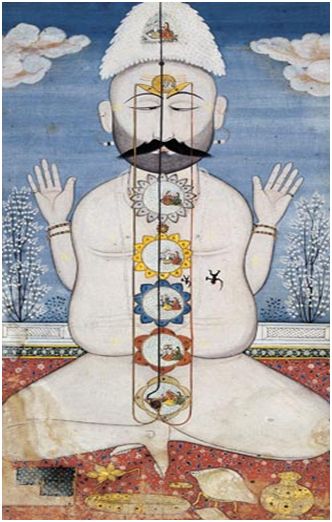
Fig. 5. Outline of visualized channels when practicing Kundalini awakening
Methodology of urgent increase of heat production based on adapted yoga practice of internal heat ’gTummo’
(authors: Ivanov A.I., Minvaleyev R.S. and Timofeyev V.I. )
Conditions of use:
A secluded place to minimize distractions. A cold ambience is advisable to provide feedback of the effective mastering of the practice and for excessive heat removal (overheat protection). For instance:
1) sitting in the cold in sub-zero temperatures (in a park, on a balcony);
2) sitting in cold water with the head above the water (it could be an ice bath;
3) sitting in a waterfall with the head not under the falling water.
Sequence of actions and visualizations, whose aim is to provide the regular muscular tension (ideomotion):
Warm-up exercises (can be done in outdoor apparel):
1. Take a Patanjali asana, i.e. a comfortable and steady sitting position (Lotus, Halflotus, cross-legged; if necessary sit on something soft to provide lumbar lordosis and to avoid distraction).
2. Do exercises Trul khor (sipping lion, pulling bow (fig. 6), twisting, stretching upwards, self-massage of the torso to the limbs and other Tibetan fitness, for instance, by G.N. Mouzroukov [Mouzroukov, 2013]).
3. Straightening of the spine by setting the hands against the thighs and bringing the shoulder blades together simultaneously.
4. Blowing each nostril in succession pinching the other one.
5. Agnisara (Nauli).
6. Filling like a Vase - a breathing technique: slow and quiet inhales and exhales monitoring the air flow in the nostrils (cool when inhale, warm when exhale), with the emphasis on abdominal breathing (puff the lower abdomen when inhale, gather it in when exhale). It is performed until getting the feeling of tranquilization, muscle relaxation and the ability for keeping a steady focus.
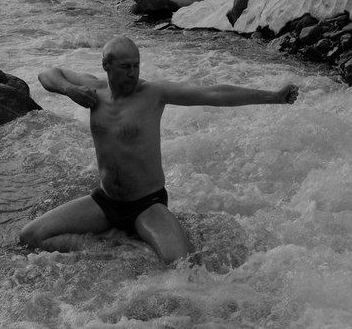
Fig. 6. Preparatory exercises Trul khor at the upper reaches of the Beas River (Northern India). Performed by V.I. Timofeyev
Main practice
1. Obligatory nose blowing via each nostril in succession (see the warm-up exercises) to clear the airways.
2. Do the asana. Imagine (visualize) a straight tube inside your body (Sushumna/Avadhuta) – ideomotor technique to keep the back straight (sit as stiff as a poker). The tube is open through the top of the head.
3. Inhale and while gathering in the lower abdomen, do Agnisara (Nauli) until the feeling of warmth in the chest or back behind the sternum (the start of extreme heat production).
4. Cup the hands together placing the right hand over the left one four fingers below the belly button joining the thumb cushions together over the cupped hands. Press without any tension the joined thumbs below the belly button (ideomotor indication of the area of starting up heat production – see below).
5. Exhale three times slowly and tranquilly, each of the inhales should be longer than the previous one, until alveolar air is disposed of, then inhale in three stages making each intake of breath longer than the previous one.
6. Inhale slowly and deeply keeping your back straight and bringing the shoulder blades together, and keep Jalandhara Bandha so that you could see the joined thumbs.
7. When inhaling, visualize two streams of air through the left and right nostrils separately and direct the both visualized air streams ("winds") on the right and left of the central visualized tube (Sushumna / Avadhuta) downwards (four fingers below the belly button where the cupped hands are - ideomotor obstacle to dropping the "wind" down).
8. Enhance the obstacle to dropping the "wind" (visualized air flow) downwards by doing easy Mula Bandha (the strain should be the same as to regularly prevent the emission of the amassed gases in the intestine - the same "winds" from the intestine).
9. Lower the diaphragm puffing the abdomen slightly (Filling like a Vase).
10. Visualize a balloon in the lower abdomen with an ejecting tube upwards (Sushumna / Avadhuta). The tube is closed off by keeping Jalandhara Bandha ("sealed up vase", i.e. Kumbhaka).
11. Squeeze "the balloon" from the bottom on the right and left by tightening the crotch upwards (in fact, intensify Mula Bandha).
12. Imagine bending of the left and right flows of the visualized "wind" following the muscle tightening of the crotch (Mula Bandha), as if joining the both flows into the central visualized tube on the right and left below keeping in your mind the contact of the thumbs above the cupped hands and the abdomen area slightly lower the belly button (see para. 4) (fig. 7).
13. Exhale slowly, visualizing the out-breath through the central tube, as if releasing the air out of the visualized balloon in the lower abdomen by squeezing it from below (Mula Bandha) and from above with the diaphragm.
14. Observe how a fire ball appears in the abdomen and starts heating the whole body, which can sometimes be felt already after the practice (the feeling of heat should arise by itself without any images of fire, a burning coal and so on).
15. For some time stay in the sitting position and enjoy the released heat. Then repeat the practice from para. 5 to 13, but add Agnisara if necessary (para. 3).
16. The termination of the practice should be done gradually. For instance, walk out of the water and in the open air continue the practice of the heating breathing for some time to keep the thermal balance.
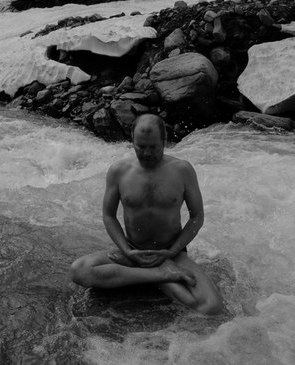
Fig. 7. gTum-mo practice at the upper reaches of the Beas River (Northern India). Performed by R.S. Minvaleev
Safety measures
1. The practice should be set about against relative physical health.
2. Terminate the practice in case of cold shivering.
Conclusions
1. The physiological component of gTum-mo practice comes down to methods of increase of heat production which is verified by cold tests.
2. Two technologies have been reconstructed which derivate from famous Hatha Yoga: 1) Agnisara/Nauli, 2) the sequence of muscle locks (Bandhas) for so-called Kundalini awakening.
3. The visualizations come down to ideomotor instructions to provide the right (for gTum-mo yoga) tonic and dynamic straining of the corresponding set of muscles and/or respiratory movements.
Acknowledgments
We thank Arkhipova I.V., the CEO of the Faraon studio of historical films and the organizer of international research expeditions to the Himalayas, carried out through the project “V poiskakh utrachennykh znanii” (In Search for Lost Knowledge).
References
- Bassett D.R. Scientific contributions of A. V. Hill: exercise physiology pioneer. Journal of Applied Physiology, 2002 (Nov), 93(5): 1567-1582. doi: 10.1152/japplphysiol.01246.2001
- Bendall J.R. Muscles, molecules and movement. An essay in the contraction of muscles. London: Heinemann educational books LTD, 1969.
- Benson H. The Relaxation Response NY: William Morrow, 1975.
- Benson H. The relaxation response: history, physiological basis and clinical usefulness.” Acta medica Scandinavica, Supplementum, 1982, 660: 231-237.
- Benson H., Lehmann J.W., Malhotra M.S., Goldman R.F., Hopkins J., Epstein M.D. Body temperature changes during the practice of gTum-mo yoga. Nature. 1982 (January), 295(5846): 234–236.
- Burton A.C., Edholm O.G. Man in a cold environment Physiological an Pathological Effect of Exposure to Low Temperatures. London: Edward Arnold, 1955.
- Clausius R. Über die bewegende Kraft der Wärme und die Gesetze, welche sich daraus für die Wärmelehre selbst ableiten lassen. Annalen der Physik, 1850, 155: 500–524. doi:10.1002/andp.18501550403
- Cromie W.J. Meditation changes temperatures: Mind controls body in extreme experiments. Harvard Gazette, 2002-04-18. URL: https://news.harvard.edu/gazette/story/2002/04/meditation-changes-temperatures/ (accessed August 15, 2018).
- Cypess A.M., Lehman S., Williams G., Tal I., Rodman D., Goldfine A.B., Kuo F.C., Palmer E.L., Tseng Y.H., Doria A., Kolodny G.M., Kahn C.R. Identification and importance of brown adipose tissue in adult humans. The New England Journal of Medicine., 2009 (Apr) 360(15): 1509-1517. doi: 10.1056/NEJMoa0810780.
- David-Néel A. Mystiques et magiciens du Thibet. Paris: Plon, 1929.
- Eliade M. Yoga: Immortality and Freedom. NY: Pantheon, 1958.
- Fanger P.O. Thermal comfort analysis and applications in environmental engineering. NY: McGraw-Hill, 1970.
- Herman I.P. Physics оf the Human Body. Berlin, Heidelberg: Springer, 2007.
- Hill A.V. The heat of activation and heat of shortening in a muscle twitch. Proceedings of the Royal Society of London. Series B, Biological sciences, Vol. 136, No.883, (1949): 195-216.
- Ivanov K.P. “The muscle heat production after adaptation to cold.” Medical biology, 1980 (Apr), 58(2): 76-81.
- Ivanov K.P. Osnovy jenergetiki organizma: Teoreticheskie i prakticheskie aspekty. T.5: Jenergetika zhivogo mira. Fiziologicheskie problemy. (Principles of energetics of an organism: Theoretical and applied aspects. Vol.5: Energetics of animate world. Physiological problem.) [In Russian], Saint-Petersburg: Nauka, 2007.
- Katkov A.J. Golod protiv holoda? (Hunger against Cold). Himija i zhizn’ (Chemistry and life), 1978, 1: 55-58.
- Kozhevnikov M., Elliott J., Shephard J., Gramann K. Neurocognitive and Somatic Components of Temperature Increases during g-Tummo Meditation: Legend and Reality.” PLoS one, 2013(Mar), 8(3): e58244. doi: 10.1371/journal.pone.0058244.
- Laletina E. Mozhno li vyzhit’ golomu na vysote 7500 m pri -60 gradusah? (Can you survive naked at the height of 7500 m at -60 degrees?) [In Russian] http://russianclimb.com/russian/korshunov5.html (accessed August 15, 2018).
- Minvaleev R.S., Bogdanov A.R., Bogdanov R.R., Bahner D.P., Marik P.E. “Hemodynamic Observations of Tumo Yoga Practitioners in a Himalayan Environment.” Journal of Alternative and Complementary Medicine, 2014 (April), 20(4): 295–299. doi: 10.1089/acm.2013.0159.
- Mouzroukov G. La pratique de base des six enseignements de Naropa: le yoga de l’éveil de la chaleur interne. Paris: Ed. Médicis, 2013.
- Pasachoff J.M., Strassburg M.A., Benson H. Body temperature changes during the practice of g Tum-mo yoga. Comment and replay. Nature. 1982 (July), 298(5872): 402.
- Readings on The Six Yogas of Naropa. Translated, edited and introduced by Glenn H. Mullin. Ithaca (USA): Snow Lion, 1997.
- Tantric ethics: an explanation of the precepts for Buddhist Vajrayana practice. Translated by Gareth Sparham; foreword by Jeffrey Hopkins. Boston: Wisdom Publications, 2005.
- Teaching of Tibetan yoga, Translated and annotated by Garma C.C. Chang, New Jersey: Institute for Inner Studies Inc, 1963.
- The Yoga Upanishads. Translated into English (on the basis of the commentary of Sri Upanisad-Brahma-Yogin) by T.R. Srinivasa Ayyangar, B.A., L.T. and edited by Pandit S. Subrahmanya Sastri, F.T.S. Adyar, Madras: The Vasanta Press, 1938.
- Thubten Yeshe. The Bliss of Inner Fire: Heart Practice of the Six Yogas of Naropa. Boston:Wisdom, 1998.
- Trincher K.S. Über das Wasser und die Warmblütigkeit. SANUM-Post, (1991), 15: 21-26.
- Trincher K.S. Teploobrazovatel’naja funkcija i shhelochnost’ reakcii legochnoj tkani (The Heat-Forming Function and Alkalinity of Reaction of Lung Tissue) [In Russian], (Moscow: AN SSSR (USSR Academy of Scinces), 1960).
- Wylie T. Ro-Langs: The Tibetan Zombie. History of Religions. 1964 (Summer), 4(1): 69-80
Файлы для скачивания:
